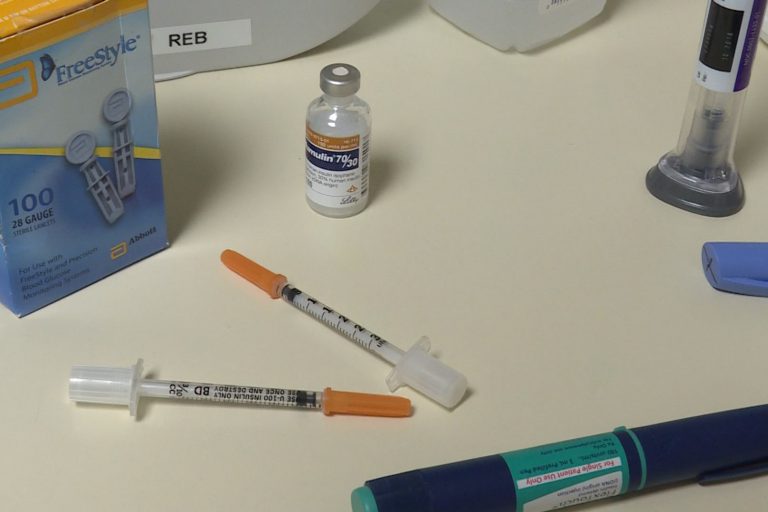Insulin is not a new drug, but even though it’s been around for nearly a century, its price continues to climb.
People with Type 1 Diabetes have to take it to regulate their blood sugar.
But a recent study from Yale shows as many as a quarter of people who need insulin ration it because it’s too expensive.
Despite having insurance and a full-time job, as recently as a couple of months ago Sa’Ra Skipper was putting herself in risky situations trying to ration her insulin, or borrow from her sister who is also a Type 1 diabetic.
“When I’m using her prescription, I mean it’s taking away from her, so if she runs short, then it’s like a double edged sword, kind of,” says Skipper. “Which we ran into some trouble last summer. We were sharing a vial of insulin and I had took my portion and somehow our wires got crossed and she took half of hers thinking I hadn’t already taken mine and so the next day she ended up sick and was in the hospital for four days.”
Skipper recently decided to talk publicly about the challenges she faces on NBC Nightly News, and she was met with an outpouring of support and insulin donations.
“It’s been a rough three or four years in all honesty but I’m so grateful to all the people who donated because now I know I’m going to be ok,” says Skipper. “I don’t have to worry about it because I know I have a supply that will last.”
Her story is similar to those of other people who struggle to afford the insulin they need.
Franciscan Health Endrocrinologist Dr. Michael Hancock says at least three or four times a day a patient mentions some sort of struggle in paying for their insulin.
“I certainly have patients who have reduced the dose or skipped it completely,” says Hancock.
The problem is if they reduce their insulin, their blood sugar will rise higher than it should.
“If it was a just a number and it had no consequence I don’t think it would get nearly the amount of attention it does,” says Hancock.
Higher numbers over a period of time can cause serious medical problems, including blindness, kidney failure, an increased risk of heart disease and stroke, and even death.
According to the American Diabetes Association, the price of insulin nearly tripled from 2002 to 2013
Fran Quigley is an advocate with People of Faith for Access to Medicines and a professor at the Indiana University McKinney School of Law.
“There are three companies that have total control of this market and they have a customer base that has to have the product to survive,” says Quigley. “So they can raise it to whatever price they want to and to be honest they have raised it to be enormously high and people still pay it because they have to pay it to survive.”
Those companies are Sanofi, Novo Nordisk and Indianapolis-based Eli Lily.
Eli Lily did not respond to multiple requests for comment.
But the drugmakers have long said their prices reflect the time and effort it takes to develop products and the risks the companies take on.
“There’s been some really important recent research that analyzes the cost of manufacturing insulin, and the estimate is it costs about $5 to manufacture the same vile of insulin that costs about $300 or more,” says Quigley.
Drug company executives were called before Congress last week to explain their prices.
Eli Lilly wasn’t there, but in response to growing pressure the company announced this week it would begin selling a cheaper version of its top-selling insulin Humalong.
In a statement Lilly’s chairman and CEO David Ricks says the cheaper insulin will be address gaps in the current pricing system:
“For people with diabetes,” he wrote, “a lower-priced insulin can serve as a bridge that addresses gaps in the system until a more sustainable model is achieved.”
But while critics say the half price generic is good, they think Lilly and other drugmakers could still do a lot more to lower prices while continuing to make a profit.
Dr. Hancock says there’s plenty of blame to go around.
“Between the patient and their drug manufacturer there’s me. There’s the doctor. There’s the pharmacy. There’s the insurance company. There’s the pharmacy benefit administrator. There’s the wholesaler and then there’s the drug,” says Hancock. “So as that drug moves through the chain, every time it changes hands that’s the opportunity for a fumble.”
“I find it, it’s just heartbreaking really,” says Skipper. “Innocent people have lost their lives due to this”
And while Sa’Ra Skipper thinks change will come, she wonders why it has to be so complicated.
“This is a big deal and people have suffered long enough I feel like so we need a change,” says Skipper. “There’s no superfood or anything that’s going to get rid of Type 1 diabetes. You have to have insulin or you will die and it just doesn’t make sense that it’s this hard to get it. We don’t have it and we die.”
Meanwhile congress says it plans to continue its investigation into the three major insulin makers and that Lilly’s decision to offer a generic version of Humalog will be part of that investigation.

